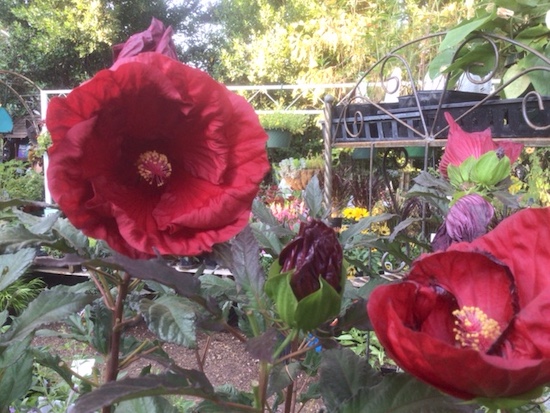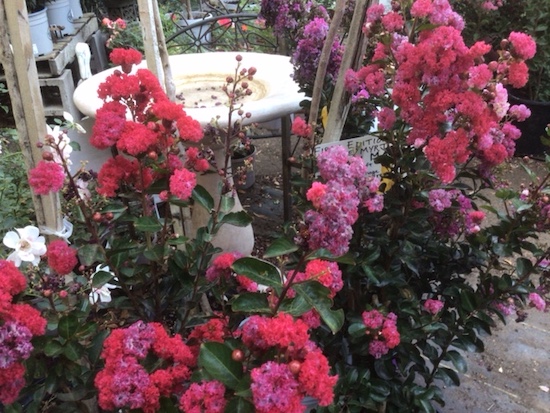
Lovely scene
Here we are in the 8th month of 2022. We are in the transition time between the ending of summer plants and before cool season plants become available. It is also a time of continued heat stress on plants, but the days are not as long, so plantings should be getting a little relief from the long hot days of July.
Reporting on my own small vegetable garden, I have harvested one pepper so far. My cherry tomatoes are starting to have color but only green tomatoes on my larger ones. Nothing but male flowers on my zucchini. I am beginning to be jealous of those people who have too much zucchini. They should count their blessings because better too much than not at all. No cucumbers yet. My garden tends to do much better as the days get shorter, so here is hoping I can still make a few batches of pico de gallo.

Hibiscus moschetos
Several people have reported their tomatoes are flowering but falling off with no fruit set. It is possible they are not pollinating. One of the main causes of this is our high daytime temps over 85. Combine that with the fact that on some nights here at the nursery on the valley floor, it also drops below 55. The pollen actually becomes nonviable under either of these conditions. A lot of days here, I can see almost a 100-degree swing in temperature in a 24-hour period. 50 to 100 and then back down again. Great for people that it cools off at night but not so great for summer vegetables. Many of you have resorted to shading the vegetable garden during the hottest part of the day, which might also help with a little heat retention at night. I know my garden is not in the full sun anymore. Excessive wind can dry up your flowers, as can too little or too much water. Keep your plants evenly watered, and mulch can really help with that. I have read that correct watering is critical to the plant absorbing calcium which prevents blossom end rot (the browning of the bottom of the fruit) and with fruit set. Over and under fertilizing could be a factor. Too much nitrogen in fertilizer is counterproductive. Best to use a balanced all-purpose like our EBStone 5/5/5. Crop rotation can also help as it is a bad practice to plant nightshade members in the same place year after year.
It is time to start thinking about the winter garden. If you plan on growing from seed, now is the time to start. Broccoli, kale, beets, lettuce, peas, cabbage, etc., can all be started now indoors to transplant out. You can also plant another batch of beans from seed and transplant cabbage, and brussels sprout starts out this month. Kale, broccoli, and chard starts are probably okay too. I would still wait to seed out carrots, turnips, and beets till the end of the month/first of September. We are waiting to hear from our seed supplier that they are ready to take our cool season seed order, but we still have several varieties of cool season vegetable seed in stock now.

Coreopsis
If you have not fed your plants lately, a good feeding is in order, especially for your vegetable garden. This will help keep things blooming and producing for August and September. Remove spent blooms from your roses and perennials to keep them in flowering mode as opposed to seed setting mode. We call this deadheading. So far, we have had no tomato hornworms, but Deb reported seeing a hummingbird moth in the salesroom, so we can expect to see a few soon. We also have seen a monarch at the nursery for the first time in a long while and have at least 3 resident swallowtails that flit through the nursery on a daily basis. Here is where things get tricky. We are going to need to identify the caterpillars for these beautiful creatures and just let them eat some of our plants if we are going to do our part in keeping the species going. Then there are the small white butterflies. The caterpillars of these are the smaller green ones that eat your petunia and geranium flowers, often before they open. Hence the name budworm. If you see little black specs on your leaves (fecal droppings) and holes in your buds, you have them. You can spray with Bt or remove it by hand. The same goes for the tomato hornworm.
Watering takes up a lot of our time here at the nursery, and we are feeling like it is time to have an end-of-summer plant inventory reduction sale. We overstocked this year now that sales are back to normal after the last two high demand covid years. This will not include houseplants, citrus, or olives, but just about any other flower, tree, grass, or shrub will be 20% OFF for the month of August. This includes all of our great hibiscus, butterfly bushes, and crape myrtles, along with the late summer blooming perennials.

Crape Myrtle
Speaking of late summer bloomers here are a few: Caryopteris, also known as blue spirea or bluebeard. This is a deciduous shrub-like perennial to about 3 ft and is deer resistant. Dwarf Plumbago, is a clear blue flowering ground cover that gets deep red foliage in the fall before going completely dormant for winter. Chrysanthemums, are always a fall favorite. Long blooming plants like Dahlias, Blackeyed Susans, Russian Sage, and Coreopsis. Salvias like the Autumn Sages that really do some of their best blooming in the fall.
Many people make the mistake of buying color in the busy spring planting time only to find that by summer time the flowers are done, and there is nothing blooming in the yard. When planting your yard, it is a good idea to think ahead and get a variety of plant materials, so you have year-round interest. I start with a few early blooming shrubs like Rosemary, Quince, Forsythia, and Lilacs. Spring blooming bulbs are a good idea too. Next are a few Butterfly Bushes and Spanish Lavender that start blooming early to mid-spring, followed by English Lavender and Jerusalem Sage in May/June. By mid to late summer Russian Sage, Rose of Sharon, and Crape Myrtle shrubs give me color. In fall, I love the grasses and Autumn Sages. Add in spring-fall blooming perennials like Gaura and Coreopsis, and that will provide you with a great canvas on which to add your favorites.

Mandevilla
August Specials
20% OFF trees, grasses, shrubs, perennials, succulents, and annuals
- Just about every outdoor living thing at the nursery
- Not included: Houseplants, Citrus, and Olives
- Sale starts July 30.
420 Premium Potting Soil – $2.00 OFF

Salvia